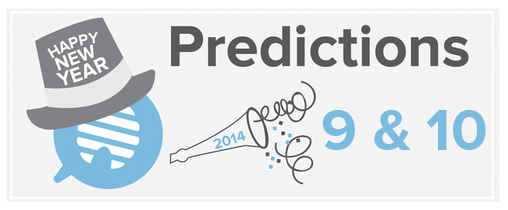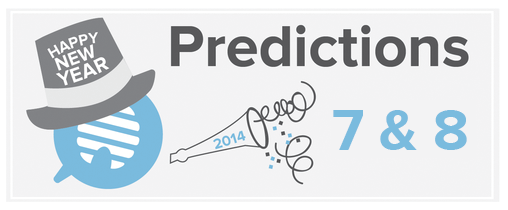Recently, Hubspot picked up on this copy line to define their newest product offering … Hubspot3 which adds contextual marketing + advanced personalization to this product, which we and our clients use to generate leads and nurture them until they are ready to buy – at which point we hand off the lead to sales by integrating through to SalesForce.
We work with clients to help them understand how to effectively engage with their buyers using the web, Facebook, Twitter, LinkedIN, Slideshare and a host of other tools at their disposal. The technology and tools we use change fast. Most of our target customers either sell B2B (business-to-business) or products to consumers that are a considered purchase (architects, interior design).
As fast as the technology changes, so too are our client’s target customers. They’re getting really, really good at blocking out content that isn’t relevant and compelling to them, content they deem “advertising” no matter what format you deliver it in:
- Email – lets block it with a SPAM filter!
- Phone calls – caller ID – let’s just not answer it!
- Snail mail – straight to the circular file (the trash can)!
- 30 second spots – watch TV commercial free thanks to the DVR built into most cable-top boxes!
But if your marketing can’t keep up, your sales funnel is in serious danger of drying up. So how on earth is a marketer supposed to deliver their compelling message?
The answer is by creating remarkable, engaging content that your target buyers want to consume, that helps them answer their questions and challenges they face in their daily lives and work.
If content pulls your target audience into your funnel, then context pulls them through the funnel to the point of sale.
Amazon.com is a great example of contextual selling – they present you with further offers based on what they already know about you and your preferences, and not on demographics. In other words, based on your online behavior rather than the fact that you are a middle aged woman, in a particular income bracket who lives in a certain city or suburb. Their marketing is context sensitive.
How well you deliver a truly personalized experience a potential customer will love depends on a number of core elements:
#1 One single version of the truth, housed in the “Mother of All Database” – MOAD
The roots of content marketing + inbound marketing is direct marketing. And in direct marketing, we know the value of capturing data in a single place. Every element of a prospect’s interaction with you – every email, every social interaction, every page visit on your site, every form they have completed – must be in a single repository.
All marketers will tell you that the more databases you have the more problems you have. Keeping a single version of the truth is the bedrock for all that follows.
#2 Social publishing
Share and publish you’re remarkable content simply and easily. Schedule your publications at a time that works for your followers. Know and understand the times of the day and week that work best and have the best rate of uptake. Hint: If you’re unsure what that time is, you can leave it up to Hootsuite, who have recently rolled out their “Auto-schedule for optimal times” feature.
But does social media really work? At the recent Content Marketing World conference marketers listed social media #11 in a list of the top 10 effective content marketing techniques. Dead last. Why? Most of us are not using social media correctly. Understand whether your prospects are reacting, sharing, and clicking through on the links you embed in social media. Analyze your social media interactions. By understanding whether your contacts and prospects are actually reacting and interacting with you (eg. by retweeting or liking your content), you’ll know if you have hit the content nail on the head. Hint: when prospects and customers interact with you in this, it should increase their lead score.
#3 Contextual Landing Pages
The landing page is a well known marketing best practice for getting visitors to convert and give you their contact details. The challenge is to create landing pages that are effective and convert very well.This means making it as simple as possible for visitors to get what they want without putting big barriers between them and your remarkable content. Many a time have I arrived at a landing page only to click off completely because of the daunting amount of required fields in the form.
Your landing pages should be smart and only ask your leads what you DON’T already know about them. If you already know that data, dynamically change that particular form to that particular respondent to remove that particular field. Your click through rates will soar.
#4 Contextual Call-To-Action buttons
The CTA is an excellent and effective way to drive visitors to your content and should be littered liberally throughout your site and in social media channels. But its much more powerful to know how effective that CTA is, typically via A/B testing. Send 50% of your traffic to one CTA and 50% to a second and test which one converts better.
Better still, is to know which of your vistors has already clicked on that particular CTA and downloaded that particular eBook already. Then, instead you can send them to a different offer, perhaps an offer that is further down the funnel, for example a demo or free trial of software rather than an eBook to use our earlier example. Personalizing calls to action will drive up conversion rates.
#5 Next generation email personalization
Email marketing remains a powerful tool to communicate with people you already know. However, too often we use email as a mass market tool, versus personalizing the email in simple ways that make sense.
By integrating your CRM database with your website contacts database and your email engine, you can personalize your email almost infinitely, based on visitor and lead behaviour. For example, you have a visitor who has downloaded an eBook, why not have the auto-reply email come from the account manager who is responsible for that account, rather than the impersonal “noreply@acme.com”?
#6 Personalizing marketing automation
Marketing automation is a rapidly growing type of software that sits on top of your CRM software. The ideal solution – whether from Hubspot, Pardot, Optify – ties directly into Salesforce or your other CRM system while allowing marketers to quickly and easily:
- personalize email
- deepen engagement with prospects
- create and test various landing pages and call-to-actions
- support trigger based campaigns for lead nurturing
A trigger-based campaign recognizes that buyers with purchase your product when they are ready and no amount of “sales” or “marketing” on your part can change this. (This is true in B2B and with considered purchase products; it is less true with other products that are low cost, low involvement, or impulse buys.) Trigger campaigns are set up so that a specific event (for example an action that a website visitor or contact takes) and sets off a series of activities, such as a series of personalized nurture emails based on that action. Most marketing automation systems support this type of functionality. If yours does not, it may be time for you to consider moving up to a more advanced system such as Pardot or Marketo. Hubspot recently enhanced its system to support personalized trigger campaigns in just the way described.


